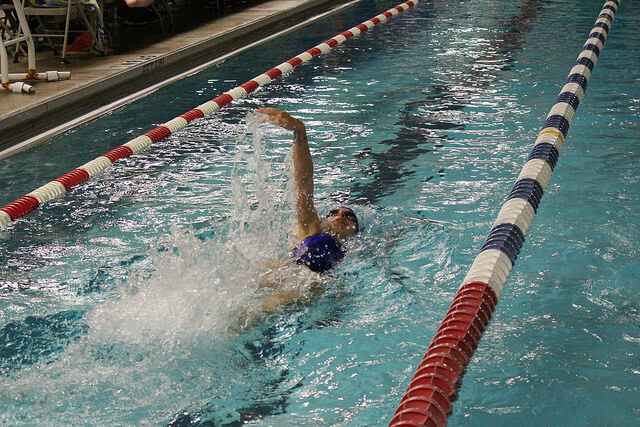Are Swimmers and Runners Actually Alike?

By Kaylie Williams, Swimming World College Intern.
There are few swimmers who will contest that they enjoy running. Likewise, there are few runners who like to swim. Although there is speculation about which sport may be more beneficial overall, there is no doubt that each sport is equally challenging both mentally and physically. What swimmers and runners do not realize is the fact that their sports are more alike than they may think. When directly compared, swimmers and runners burn similar amounts of calories, use related muscle groups and perform parallel mechanics in their workouts.
Average Calories Burned Swimming

Photo Courtesy: flickr
The amount of calories that an athlete will burn depends on the relationship between many factors. A person’s weight, intensity of the workout, stroke and distance can significantly alter the caloric burn rate and energy expended throughout. A competitive swimmer who trains daily and has great technique will burn less calories because their body is more adapted to the type of workout and does not have to work as hard due to their fine-tuned technique.
According to data from active.com, an average “130-pound person swimming freestyle for an hour will burn 590 calories swimming fast, and 413 calories swimming slower.” The burn rate is impressive, but once you ramp up a person’s weight, the caloric burn rate increases significantly. The source states that a 205-pound person doing the same workout will burn 913 calories swimming fast and 657 calories swimming at a slower rate.
After you factor in different strokes, the rates increase even more. Swimming the breaststroke for an hour is equivalent to swimming an hour of fast freestyle in terms of calories burned. Similarly, an hour of backstroke is equivalent to an hour of slow freestyle. If you’re looking to torch some major calories, your best option is butterfly. If you dare attempt it, on average, swimming butterfly for an hour would burn upwards of 1,000 calories!
Average Calories Burned Running
In comparison, running burns similar amounts of calories but requires the athlete to cover more distance with a weight-bearing component. Running for an hour at a nine minute mile pace would burn anywhere from 649 to 1,024 calories depending on your weight. According to running.competitor.com, the rule of thumb for calculating the amount of calories burned in a running workout is 100 calories per mile. Therefore, “a person running 10-minute miles for an hour covers six miles and burns about 600 calories in this calculation; a person running 6-minute miles for that same amount of time runs 10 miles and burns 1,000 calories.” Just like in swimming, a conditioned runner will burn less calories doing the same workout because they too have adapted to the conditions and perfected their technique.
Muscle Groups and Mechanics

Photo Courtesy: flickr
Swimmers and runners are alike in the sense that they each participate in endurance sports. While swimming is low impact and high endurance, running is both high impact and endurance. In order to build up endurance, each athlete has to also repeatedly train their muscles and cardiovascular system to meet oxygen and energy demands.
Besides the obvious difference in mechanics that involves the use of their shoulders, swimmers and runners use the same muscle groups in their legs. Both athletes engage their quadriceps, calves and glutes and in similar ways. Swimmers use their quads to exert force on the water during the kick in order to propel themselves through the water as well as during starts and turns when they jump off the blocks and push off the wall. Runners alternate using their quads and hamstrings to swing their legs forwards and backwards in order to propel forward as well as to stabilize the knee joint and absorb impact with each step. Both feet are never on the ground at the same time! Each athlete uses their calves to provide some sort of spring in their technique, whether it is off the ground during running or used to push off the wall or blocks in swimming.
The most important muscle groups that each sport uses are the abdominal and gluteal muscles. Having a strong core is essential to both sports for many reasons. In swimming, a strong core and glutes will result in a more streamlined posture, as the glutes work to support the hips to keep them level. The core works to assist with the pull. In running, the core and glutes also stabilize the trunk, but the glutes work harder to assist the hips with the swinging motion of the legs.
The Takeaway
Swimmers may always dislike running, and runners might always dislike swimming; however, after comparing technical details, it is clear that the biggest difference is that one sport is performed on land and the other in water. Both sports require a strong, focused and determined mindset to succeed – they are easily two of the toughest sports to compete in both mentally and physically.
All research and commentaries are the opinion of the author and do not necessarily reflect the views of Swimming World Magazine nor its staff.




Wyatt MaxeyCatherine Maxey
I do both but prefer swimming more especially open watet!
Come on just look at the woman number 87, you ever seen a swimmer look like that? Narrow shoulders, skinney arms and legs. Face looks emaciated.
Your supposed facts might work for ordinary men and women, but this is Swimming World and swimmers are exactly opposite from that woman. Wide shoulders, narrow waist, strong arm and back muscles and legs and calves with actual muscle showing.
Los of swimmers look similar to #87.
She looks like a strong young athletic woman!!
no girl swimmer would have arms that thin
To my other swimmers turned runners.. Caitlyn Edmundson Melinda Spinella
Lindsey, cool! I have always said that if there were a duathlon with just swimming and running instead of biking and running I’d totally do it.
That is a aquathon race.
Caitlyn Edmundson we have done these swim/run duathlons called aquathons.
Anna Brown Millard
Josh Barila
not even gonna read it cause we are not alike
Running helps my swimming… as a Masters athlete who can’t log as many pool hours as she’s like!
Running is great if you can run. Lots of people can’t. Bad knees, flat feet, knocked knees. Biking might be a better option. But I do know many runners who swim or are triathletes.
Both for me. One helps the other!
Runner are not on the same intellectual level of swimmer…they dont have to think of feel and grip like swimmers do.
They are usually both.
They definitely don’t feel the same but mentally the same. (Just my opinion)
Melina Masselli
Julie Keller James
actually, quite different in the aspect of swimming being very low impact sport will low injuries while running require constant prevention and rehabilitation so you don’t end up injured. common thing -strong lungs.
Yes! I feel swimming is more challenging! Swimming and cross country ski racing have many similarity. .. technic- effectivity in stride Is key, training cycles and importance of volume of trainning – plus #monkeyonurback
Swimming is much more complicated and skill dependent
not really. people who think that don’t know how to run and then complain about their knee and hip injuries… caused by poor form
Christin Rockway
There was a guy at West Point years ago who was third in the indoor 3 mile at NCAA’s and was an NCAA qualifier in the 400 IM. A guy who swam for Chico State years ago also had the Death Valley Run record for a while. The guy who had the high school 500 record forever also ran cross country. The Hansen twins were recruited to swim at at U of Arizona, but found they were much better runners almost by accident . One ended up on the Olympic team in track.
Getting swimmers to be fair runners is much easier than getting runners (especially the hard core guys) to be swimmers. I’ve done both when the triathlon rage started some years ago.
Some guys and girls are gifted and can do both.Amazing!